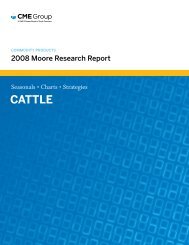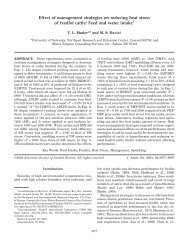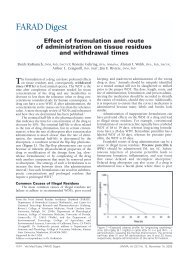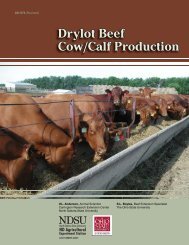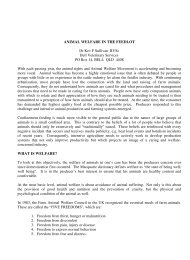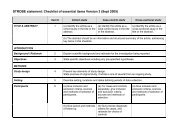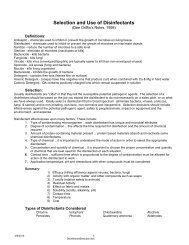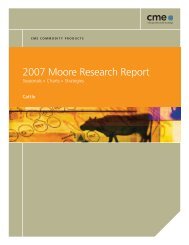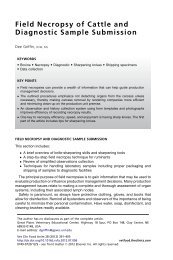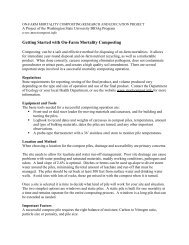CRIMES WITHOUT CONSEQUENCES - gpvec
CRIMES WITHOUT CONSEQUENCES - gpvec
CRIMES WITHOUT CONSEQUENCES - gpvec
Create successful ePaper yourself
Turn your PDF publications into a flip-book with our unique Google optimized e-Paper software.
1. Introduction<br />
The purpose of this report is to analyze U.S. humane slaughter laws and the enforcement<br />
of those laws by government agencies. Material is included related to the slaughter of<br />
animals in U.S. custom, state-inspected and federal-inspected slaughterhouses, as well as<br />
the slaughter of animals in foreign plants certified to export meat to the United States.<br />
The foundation of the report is the analysis of more than 1,000 documents gathered from<br />
approximately 60 public records requests submitted to state and federal agricultural<br />
departments over a three-year period, from early 2004 through 2006. Following is a list<br />
of the documents obtained and reviewed in the preparation of this report:<br />
State Enforcement<br />
1 All enforcement records (30 states ): January 1, 2003 to December 31, 2004<br />
Federal Enforcement of U.S. Plants<br />
2 NRs (all plants) : October 1, 2002 to March 31, 2004<br />
Notices of Intended Enforcement (NOIEs) (all plants): January 1, 1998 to<br />
September 30, 2007<br />
Suspension of Inspection (all plants): January 1, 1998 to September 30, 2007<br />
Withdrawal of Inspection (all plants): January 1, 1998 to September 30, 2007<br />
Federal Enforcement of Foreign Plants<br />
3 Annual country audits (31 countries ): January 1, 2004 to December 31, 2007<br />
In addition to analyzing government documents related to humane slaughter enforcement,<br />
this report presents information regarding voluntary industry guidelines and humane<br />
food program standards related to humane slaughter. The report concludes with<br />
recommendations for improving the humaneness of animal slaughter in the United States.<br />
1 Represents all states with meat inspection programs (28) or meat custom inspection programs (2) at the time<br />
research was initiated. As of August 13, 2007, 27 states operated meat inspection programs, with New Mexico<br />
meat inspection duties being taken over on that date by the USDA due to reported flaws in the state’s inspection<br />
services. See USDA-FSIS, Designation of the state of New Mexico under the Federal Meat Inspection Act and<br />
Poultry Products Inspection Act; final rule, Federal Register, Vol. 72, No. 134, July 13, 2007, pp. 38467-38468.<br />
See also Johnston G, Feds relieve New Mexico of meat-inspection duties, http://www.Meatingplace.com,<br />
July 10, 2007.<br />
2 While the information from state-inspected and federal-inspected foreign plants was easily obtained, the<br />
USDA-FSIS, which supplies documents related to federal inspection of U.S. slaughter plants, typically requires<br />
up to six months to produce a single document and two or more years to produce a large volume of documents<br />
requested under the federal Freedom of Information Act (FOIA). Preparation and release of this report were<br />
delayed as a result. The delay also affected the relevance of the documents received to the current status of<br />
federal humane law enforcement. The handling of FOIA requests by the USDA makes producing an accurate<br />
assessment of federal oversight of the nation’s food safety laws extremely difficult, if not impossible.<br />
3 Represents all countries approved to certify slaughter plants for export of meat and/or meat products to the<br />
United States, as of February 2008.<br />
5




